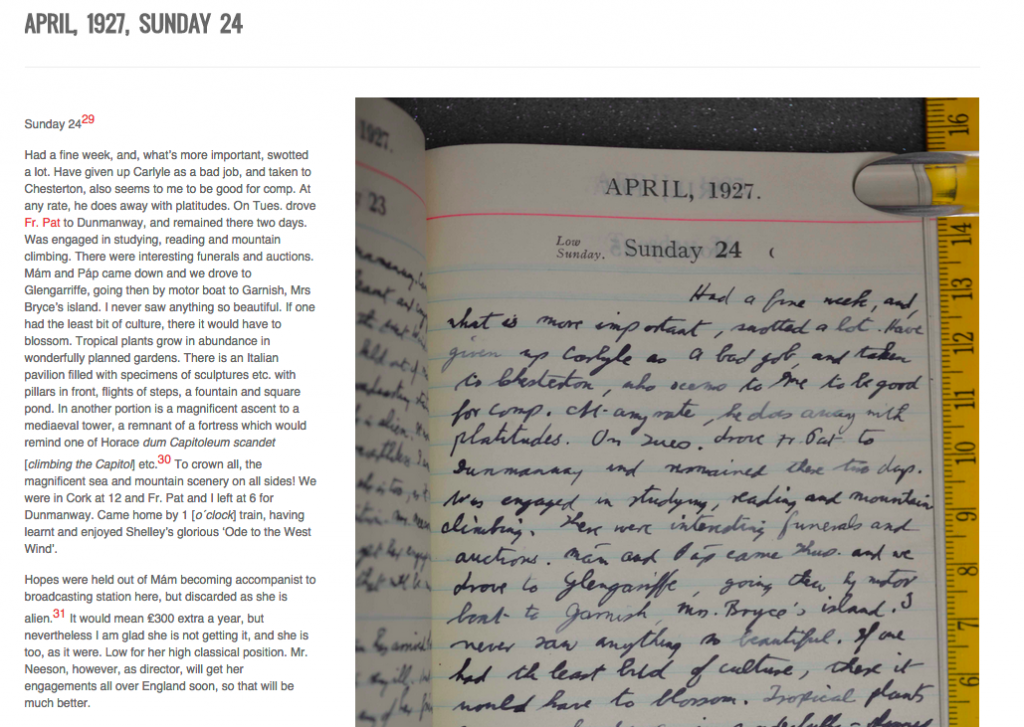Róisín O’Brien’s Fleischmann Diaries project, which digitized, transcribed, annotated, and indexed the 1926 and 1927 diaries of the Irish composer and conductor as well as some supporting material, is a superb example of a well-documented DH project. It is also a useful example to consider because of how its creators avoided the decontextualization of information that Miriam Posner discussed as common within DH projects.
The core of the Fleischmann Diaries is the Diaries themselves, which are presented as high-quality digital photographs (Róisín O’Brien discusses the process of taking them in detail here) of each page alongside the transcribed text of that page with footnotes giving context to some of the names and places mentioned in the diaries.
The diaries are indexed and can be sorted by month. Some supporting materials (photographs, newspaper clippings), are also presented. I find the decision to include both the photographs of the diary pages and the machine readable transcribed text on the same page very interesting. It helps prevent the contents of the diary from feeling decontextualized, while the transcribed text enhances readability and makes the data searchable. Additionally, it makes the information comprehensible for those who are visually impaired. I’ve noticed that the Carleton Archive at times uses the same method, but often the transcribed text is missing or formatted in ways that make it difficult to read.
Basic information on how the project was conducted are available on the website’s about page and one discussing the digitization process, but for much more detailed description and discussion of methods that the creator hopes others will use in the future, one must access Róisín O’Brien’s dissertation.
I was drawn to Róisín O’Brien’s project initially because I have a passing familiarity with the author of the diaries, Aloys Fleischmann, but what truly captured my attention was that this project is accessible to both laypeople with basic computer knowledge who want to read the diaries, and to beginning DH practitioners who are interested in the process of creating the website.
Thus, I will end this post with a breakdown of the project using Miriam Posner’s method from “How Did They Make That?:”
- Sources: Fleischmann’s 1926 and 1927 diaries, archival photographs (some from surviving family members), news clippings.
- Process: diaries were photographed using a Nikon D5200 SLR camera with a light kit and stand to achieve uniform results. Additional documents were also photographed. Diaries were transcribed, indexed, and had footnotes added.
- Presentation: website hosted by University College Cork under a Creative Commons Attribution-Non Commercial-No Derivatives 4.0 International License. Transcription and photographs of diaries are available in chronological order or indexed, and a gallery provides access to additional materials.
All in all, I was surprised at how easy it was to discover how others created DH projects, because the community does really have a “sharing” ethos.



this is a very interesting blog .
I especially love the text she provided on the sides of the pictures of the diary pages. It made it accessible to everyone and the footnotes made things very clear.This is a very interesting DH project. It would be neat to have a website following this as a model where users can digitize any diary they have. It would include the same elements of
I agree with you in saying that, Your sources, process, and presentation section was very easy to follow and informative.
I really enjoy reading you blog! You have given me a very comprehensive description of this DH project and a thorough explanation of its construction. You have clearly identified the sources, process and presentation and I utterly agree with your recognition! Moreover, I really appreciate the fact that you have involved numerous links for interaction and greater interpretation and the fact that you have accompanied your information with media information and structured bullet-points of sources, process and presentation. I don’t see how you could further improve this blog; but if there is one element you have possibly neglected to explicate, I would say that perhaps it could be the DH project’s structure.
This is a very interesting DH project. It would be neat to have a website following this as a model where users can digitize any diary they have. It would include the same elements of digital page photos, text transcription, and background cultural info .
This type of project is becoming more widespread, actually. People are making use of “citizen scientists” or “citizen historians” and crowd sourcing the labor to transcribe vast collections like this. Evan Roberts from the U of M will talk to us next week about the project he’s just launched along these lines and the potential for large scale humanities digitization projects.
This looks like a wonderful DH project. I agree that the combination of transcribed/annotated text with photos of the original entries is a great way to present the information. Also, I find it exciting that I can make a part of a comment bold, just by typing
before the text, and after it..Oops. That last part didn’t work out…